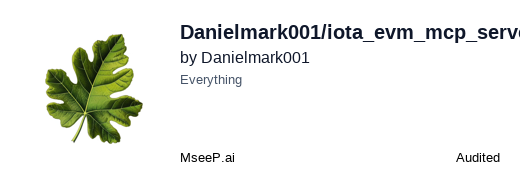About
The IOTA MCP Server offers a Model Context Protocol API that lets AI agents read state, execute contracts, transfer tokens, and access IOTA‑specific services across IOTA, Shimmer, Ethereum, Optimism, Arbitrum, Base, Polygon and many other EVM networks.
Capabilities

The Iota Evm MCP Server is a purpose‑built bridge that brings the power of the Model Context Protocol to the IOTA ecosystem and an extensive catalog of EVM‑compatible blockchains. By exposing a single, uniform set of tools and resources, the server allows AI assistants—such as Claude—to query balances, read transaction history, deploy and interact with smart contracts, and even perform cross‑chain arbitrage—all without having to manage separate RPC endpoints or SDKs for each network. This unified interface dramatically reduces the friction that developers face when building AI‑powered blockchain applications, enabling rapid prototyping and deployment across more than thirty networks.
At its core, the server offers two complementary layers of functionality. First, it provides IOTA‑specific services: native token balance checks, network health metrics (TPS, block time, gas usage), staking status, and DeFi integrations like liquidity pools and lending markets. Second, it delivers generic EVM tooling—ERC‑20/721/1155 token queries, smart contract deployment and analysis, gas estimation, ENS name resolution, and transaction analytics—compatible with Ethereum, Optimism, Arbitrum, Base, Polygon, Shimmer, and many others. By combining these layers under a single MCP contract, developers can write AI prompts that refer to any chain by name or ENS address and receive consistent responses regardless of the underlying protocol.
The server’s key capabilities include:
- Unified blockchain state access: AI agents can read balances, block headers, and transaction receipts across all supported chains with a single query.
- Smart contract lifecycle management: Deploy, call, and audit Solidity contracts directly from an AI prompt, including automated function detection and standard compliance checks.
- Cross‑chain analytics: Compare token prices, gas costs, and staking yields between IOTA and EVM chains to identify arbitrage opportunities or optimal liquidity pools.
- Human‑readable identifiers: ENS name resolution allows agents to use domain names instead of raw addresses, improving prompt clarity and reducing errors.
- Extensible resource model: New networks or tokens can be added by extending the MCP resources, making the server future‑proof as the blockchain landscape evolves.
In practice, this MCP server shines in scenarios such as AI‑driven portfolio managers that need real‑time cross‑chain data, automated trading bots that monitor arbitrage windows across IOTA and Ethereum layers, or conversational agents that help users navigate staking options on Shimmer. By integrating the server into an AI workflow, developers can focus on business logic and user experience while delegating all low‑level blockchain interactions to the MCP, resulting in cleaner codebases and faster time‑to‑market.
Related Servers
MarkItDown MCP Server
Convert documents to Markdown for LLMs quickly and accurately
Context7 MCP
Real‑time, version‑specific code docs for LLMs
Playwright MCP
Browser automation via structured accessibility trees
BlenderMCP
Claude AI meets Blender for instant 3D creation
Pydantic AI
Build GenAI agents with Pydantic validation and observability
Chrome DevTools MCP
AI-powered Chrome automation and debugging
Weekly Views
Server Health
Information
Explore More Servers
Mcp Dichvucong
Real‑time Vietnamese public service data for AI assistants
Qdrant MCP Local
Local Docker setup for Qdrant and MCP server
Google Keep MCP Server
Control Google Keep via the Model Context Protocol
Coin
Human-friendly digital currency wallet for multiple platforms
Mcp Android ADB Server
Remote Android device control via ADB with optional visual analysis
Mcp Imdb
Access and summarize IMDB data effortlessly